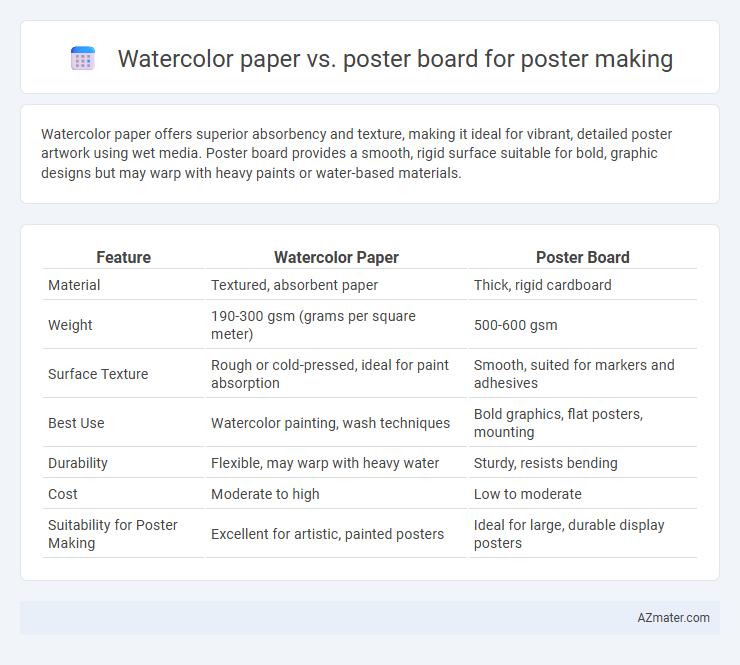Watercolor paper offers superior absorbency and texture, making it ideal for vibrant, detailed poster artwork using wet media. Poster board provides a smooth, rigid surface suitable for bold, graphic designs but may warp with heavy paints or water-based materials.
Table of Comparison
| Feature | Watercolor Paper | Poster Board |
|---|---|---|
| Material | Textured, absorbent paper | Thick, rigid cardboard |
| Weight | 190-300 gsm (grams per square meter) | 500-600 gsm |
| Surface Texture | Rough or cold-pressed, ideal for paint absorption | Smooth, suited for markers and adhesives |
| Best Use | Watercolor painting, wash techniques | Bold graphics, flat posters, mounting |
| Durability | Flexible, may warp with heavy water | Sturdy, resists bending |
| Cost | Moderate to high | Low to moderate |
| Suitability for Poster Making | Excellent for artistic, painted posters | Ideal for large, durable display posters |
Introduction: Choosing the Right Material for Posters
Watercolor paper offers a textured, absorbent surface ideal for vibrant, detailed poster designs using watercolor paints, ensuring color depth and durability. Poster board provides a smooth, sturdy base suitable for mixed media, markers, and collage, offering rigidity and ease of display. Selecting between watercolor paper and poster board depends on the desired visual effect and medium compatibility for the poster project.
Key Characteristics of Watercolor Paper
Watercolor paper is specifically designed to handle wet media, featuring a thick, absorbent texture that prevents warping and allows for smooth blending of colors. Its high cotton content enhances durability and provides excellent archival quality, making it ideal for vibrant, long-lasting posters. Unlike poster board, which is rigid and better suited for dry media and structural support, watercolor paper excels in maintaining color integrity and texture in wet painting techniques.
Key Characteristics of Poster Board
Poster board features a rigid, thick composition typically made from clay-coated paper or cardboard, providing durability and resistance to bending, ideal for long-lasting displays. Its smooth or slightly textured surface ensures vibrant color retention when using markers, paints, or printed images, enhancing visual impact. Unlike watercolor paper, poster board lacks high absorbency, making it better suited for dry media and graphic designs rather than heavy paint applications.
Texture and Finish: Comparing Surface Qualities
Watercolor paper offers a textured surface with a toothy finish ideal for absorbing watercolor pigments, providing vibrant color retention and blending capabilities. Poster board features a smooth, non-absorbent finish suited for markers, paints, and adhesives, delivering crisp edges and bold graphics without bleeding. Choosing between these materials depends on the desired visual effect and medium, as textured watercolor paper enhances depth while poster board ensures clean lines and durability.
Durability and Longevity
Watercolor paper offers superior durability and longevity for poster making due to its textured surface and acid-free composition, which resists yellowing and deterioration over time. Poster board, while sturdy and rigid, is typically more prone to edge wear and may degrade faster when exposed to moisture or sunlight. For long-lasting displays, watercolor paper's archival quality ensures the artwork maintains its vibrancy and structural integrity for years.
Paint Absorption and Color Vibrancy
Watercolor paper offers superior paint absorption due to its textured surface and thicker composition, allowing pigments to settle evenly and prevent pooling, which enhances color vibrancy and depth. Poster board, while sturdier and less prone to warping, has a smooth, non-porous finish that limits paint absorption, often causing colors to appear flat or uneven when using water-based paints. For achieving bright, vivid hues with watercolors, watercolor paper is the optimal choice, whereas poster board may require additional layers or sealing techniques to improve color intensity.
Ease of Use for Artists and Crafters
Watercolor paper offers superior texture and absorbency, making it ideal for artists who use wet media and require precise control over paint flow and blending. Poster board provides a smooth, sturdy surface that is easier to cut and glue, favored by crafters prioritizing quick assembly and durability for display purposes. Ease of use depends on the project's media and technique, with watercolor paper suited for detailed painting and poster board better for mixed-media and collage work.
Cost-Effectiveness and Availability
Watercolor paper generally costs more due to its thick, textured quality designed for heavy paint absorption, making it less cost-effective for large-scale poster making. Poster board is widely available in various sizes and finishes at a lower price point, offering an economical option for vibrant and durable posters. For budget-conscious projects requiring bulk purchases, poster board provides greater cost-effectiveness and accessibility in retail stores.
Best Applications for Each Material
Watercolor paper excels in poster making when vibrant color blending and smooth gradients are essential, offering superior absorption and texture ideal for water-based paints and detailed artwork. Poster board provides a sturdy, rigid surface perfect for large-scale displays, mixed media applications, and presentations requiring durability and easy mounting. Choosing between the two depends on whether the project prioritizes artistic effects with watercolors or structural stability for visual impact and ease of handling.
Conclusion: Which Material Suits Your Poster Project?
Watercolor paper offers superior texture and absorbency, making it ideal for detailed, vibrant designs requiring wet media, while poster board provides a sturdier, smoother surface suited for bold, graphic work and easy mounting. Choosing between them depends on your project's artistic technique and presentation needs, with watercolor paper best for intricate, paint-based projects and poster board preferred for durability and clean finishes. For long-lasting, professional posters meant to withstand handling and display, poster board typically offers the most practical benefits.

Infographic: Watercolor paper vs Poster board for Poster making
 azmater.com
azmater.com